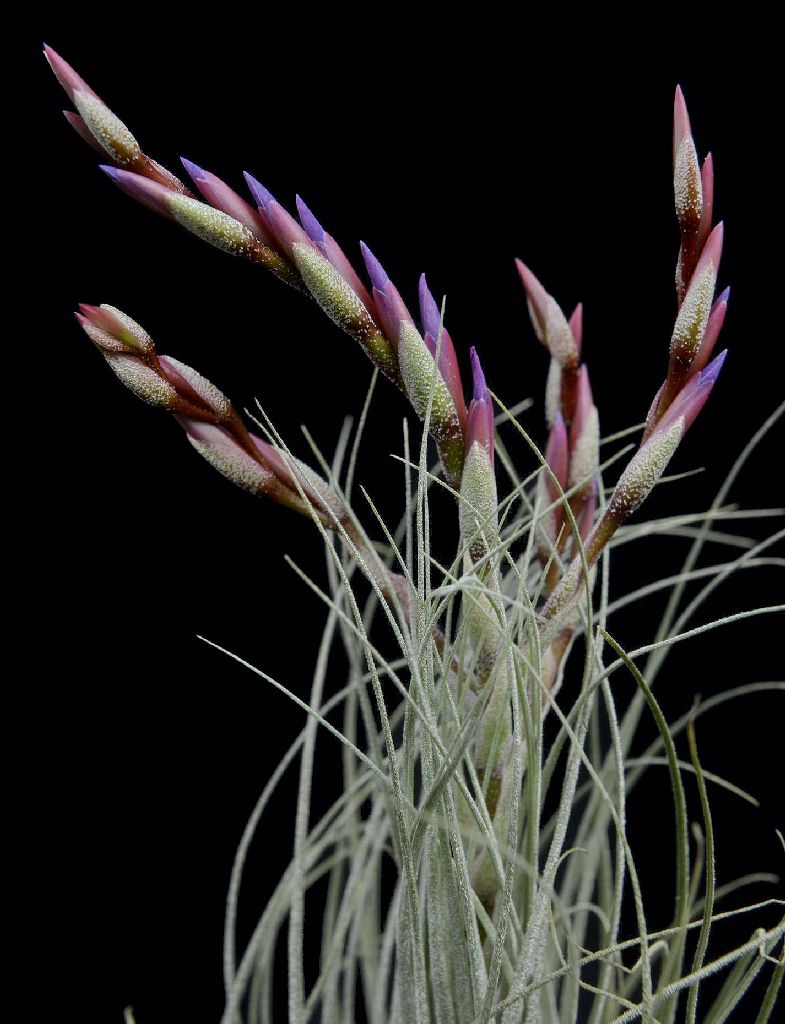
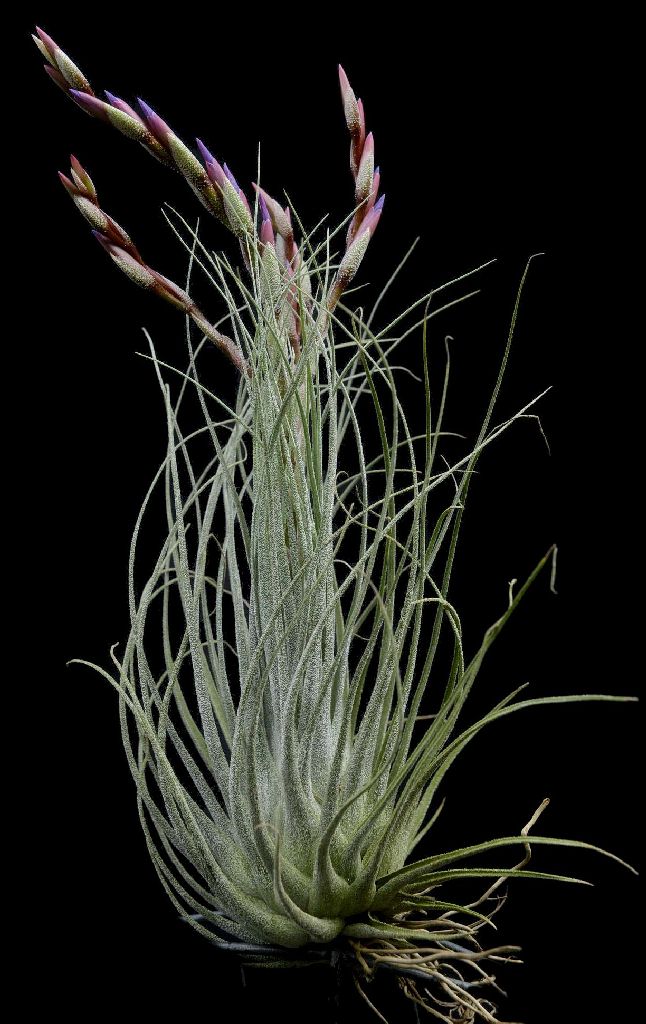
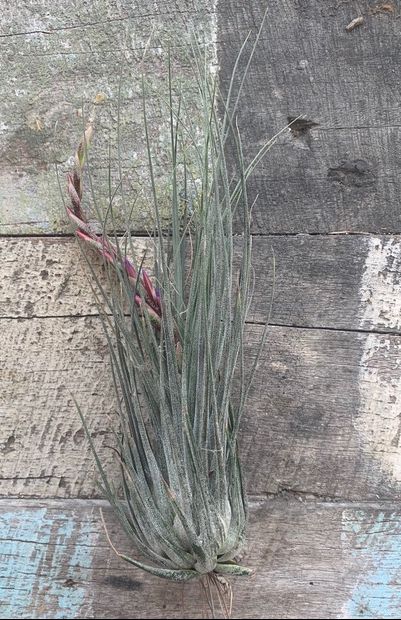
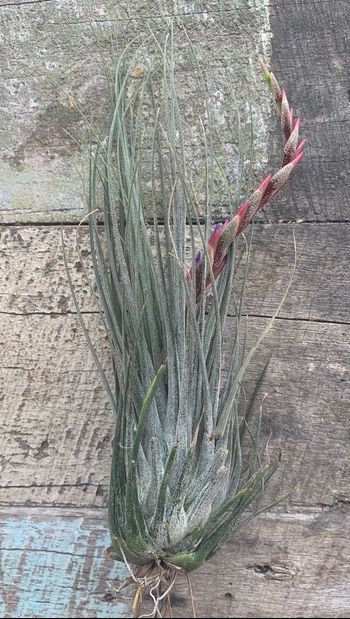

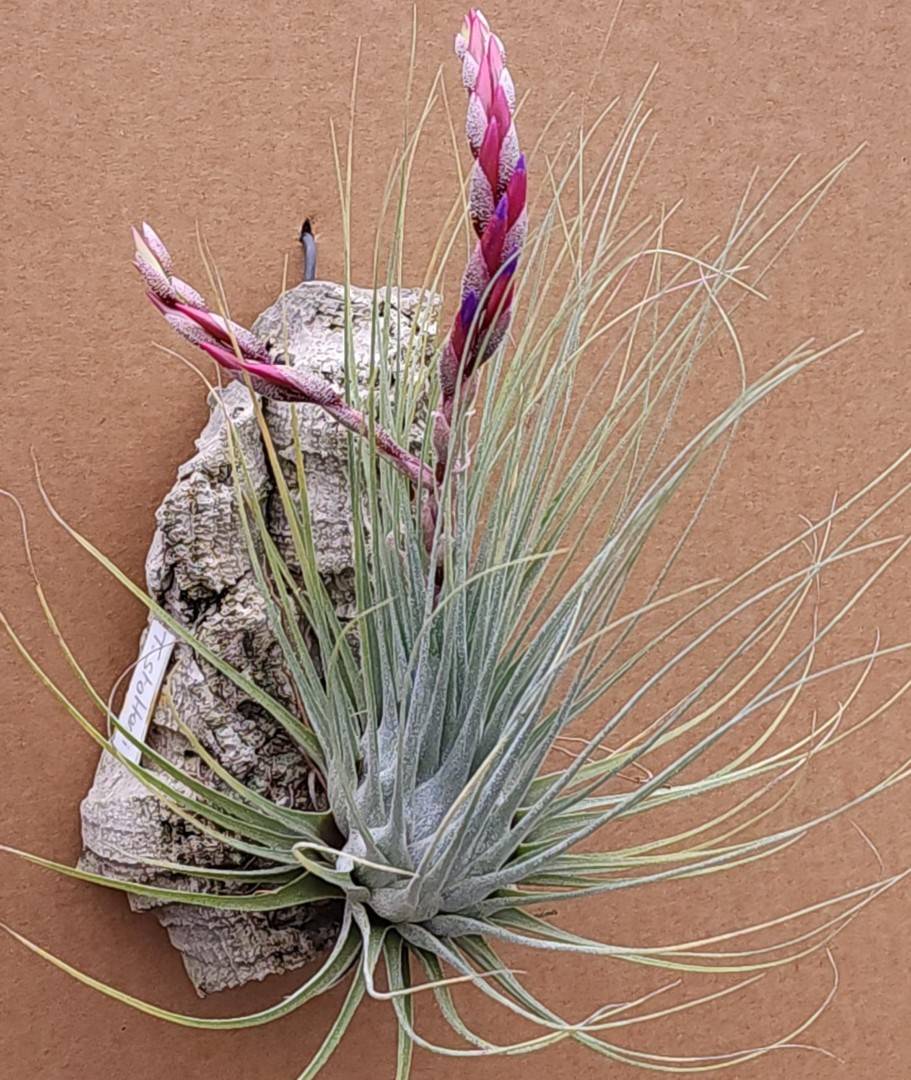
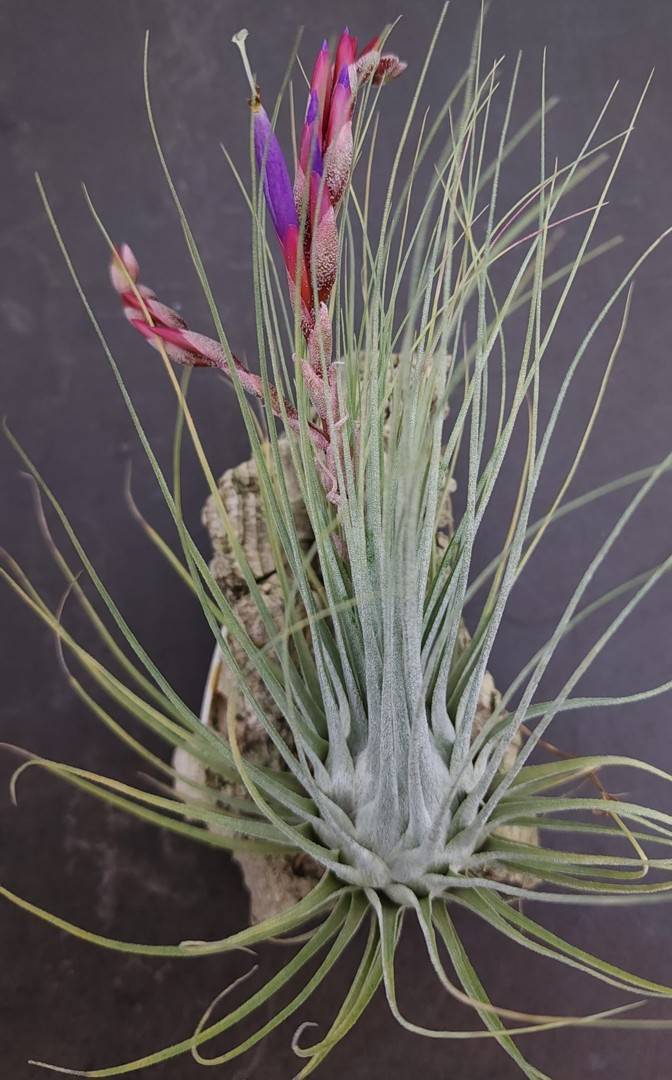

A Tillandsia socialis L.B. Sm. habitu minori, foliis duplo brevioribus basi pseudobulbum formantibus (vs. rosulam apertam), inflorescentia spicis paucis brevioribusque, densioriter composita, bracteis primariis brevioribus, rhachidi undulata usque ad geniculata subvisibile, bracteis florigeris glabris calyci distincte brevioribus, adaxialibus carinatis, floribus densioriter aggregatis et petalis minus patentibus differt.
This species seems to be related to Tillandsia socialis L.B. Sm. It differs from this by the following characteristics:
Plant much smaller; leaves only half as long, forming basally nearly a pseudobulb vs. an open rosette;
inflorescence composed of less and shorter spikes, which are more densely arranged and with shorter primary bracts;
rhachis somewhat undulate and hardly visible;
flower bracts distinctly shorter than the sepals and glabrous; adaxial sepals keeled; flowers more densely arranged and petals less spreading.
Type: Ex cult. in coll. R. Ehlers, July 1992, R. Ehlers s.n. (holo WU). To that plant the following collection data were attached: Guatemala, Depto. San Marcos, near the village Union Juarez not far from the Mexican border ca.800 m s. m., 1991, leg. U. Feldhoff s.n. (fieldbook entry).
Paratype: Ex cult. in Bot. Carden Gottingen (GOET Germany), June 2004, J. Lautner s.n. (WU). To that plant the following data were attached : “Guatemala, Depto. Huehuetenango, leg. Uwe Feldhoff" and was cultivated there as T. stoltenii".
Additional collections: Mexico, Chiapas, on the Guatemala border, at the foot of the Tacana volcano. ca. 2200 m s. m, Heidelberg Bot. Garden Nr. Rauh 73452, 1eg. R. Wulfinghoff Nr. M92/349, 1992.
Guatemala, La Mesilla, probably leg. W. Welz s.n. (cult. in HBG).
Plant up to 10 cm tall, flowering up to 25 cm tall, 4-5 cm in diameter.
Leaves ca. 15-20, 2-12 cm long, dark green, densely grey lepidote, hard leathery, the base reduced to a sheath with short apex.
Sheath 2 cm long, 2 cm wide, broadly elliptic to orbicular, concave, canaliculate, clearly distinct from the blade, forming a globose pseudobulb of 3-4 cm in diameter, adaxially grey-brown lepidote (except the glabrous base).
Blade up to 10 cm long, narrowly triangular, acuminate, margins involute, apex subulate.
Inflorescence erect, exceeding the rosette.
Peduncle slender, up to 10 cm long, glabrous, green,
basal peduncle bracts similar to the inner rosette leaves, ca. 4 cm 1ong, the sheaths almost as long as the internodes, imbricate, leaving the peduncle somewhat visible, the upper ones ca 2 cm long.
Inflorescence (fertile part) simple or once branched with (1-2) 3-6 spreading spikes,
primary bracts similar to the upper peduncle bracts, ca.1 cm 1ong, densely grey lepidote.
Spike 5-12 cm long, 8-10 mm wide, stipe 2-4 cm long, laxly covered with 8-10 mm long bracts, bracts elliptic, acuminate, weakly lepidote, each spike with 3-11 erect flowers, laxly arranged, adjacent to the rhachis, internodes ca. 1 cm 1ong, the axis somewhat undulate, but barely visible.
Floral bracts 1-1.2 cm (-1.5 cm) long, about ˝ -2/3 as long as the sepals, 6-8 mm wide, elliptic, obtuse, membranous, not keeled, nerved, adaxial finely punctulate lepidote, abaxial red or yellowish red, glabrous, towards apex very scattered fine lepidote.
Sepals 1.5-1.7 cm long, 5-7 mm wide, obovate, subobtuse, membranous, raspberry-red, glabrous, subfree (1-2 mm connate to the ovary), the basal 5 mm white.
Petals 2.8-3 cm long, 7 mm wide in upper part, spatulate, acuminate, forming an erect tube, apex not recurved, tapering down to 4 mm wide below, violet blue, the basal 5 mm white.
Stamens: filaments as long as the flower tube, 2.4-2.6 cm long, in the upper part 0.8 mm wide and pale violet, tapering towards base and white, anthers 5-5.5 mm long (dried 3 mm), 0.75 mm wide, linear, at base somewhat sagittate, attached at about the lower half of the middle, dark yellow, pollen ye1low.
Style exceeds the flower tube by 1cm, up to 3.5 cm long, thin, white, stigma small, 1.5 mm high, 1-2 mm wide, lobes green, narrow erect, spreading in postfloral stage.
Ovary 4 mm high, 2 mm wide, conical, light green.
Habitat and distribution
The plant grows in low scrub, associated with Tillandsia schiedeana Steud., T. polystachia L. and T. recurvata (L.) L.
The plant occurs on the border between Chiapas in Mexico and San Marcos and Huehuetenango in Guatemala. It grows in very dry areas.
Similar species
This species appears to be related to Tillandsia socialis L.B. Sm. It differs from this by the following characteristics:
Plant much smaller, leaves only half as long, almost forming a pseudobulb at the base, not an open rosette, inflorescence with fewer, denser spikes, spikes shorter with shorter primary bracts, flowers more dense and less spreading, leaving the axis barely visible, flower bracts noticeably shorter than the sepals, glabrous, not lepidote, adaxial sepals keeled.
Etymology
As Dr Elvira Gross has previously suggested, the new species will be named after the bromeliad friend and bromeliad grower, Timm Stolten.
History
In 1991, I got a plant from Uwe Feldhoff that he had collected in Union Juarez, and he thought that it was a new species. According to him, the plant grows in a fairly dry area together with T. schiedeana and T. recurvata in large quantities. He was of the opinion that it was not a hybrid because he had not seen any plants to consider as parents. Klaus and I were thrilled with this beautiful grey plant, which somehow looked like a T. disticha. But, this
plant only comes from South America, and we had never seen such a plant in Mexico, so our interest was great.
I wrote about the new plant to Bernd Vollmer in Berlin and asked him if he should visit Chiapas, could he look in the area around Union Juarez:
I wrote to him: “In habit, the plant looks like a T. disticha from Peru, a solid grey almost bulbous plant with short leaf blades, however, the inflorescence is a very lax spike with blue flowers."
Mr. Vollmer answered me that he had found such a plant on the Mexican side of the border with Guatemala, and it had on its label T. “disticha Chiapas". He promised to look for this interesting little plant when he was once again in this area. I mentioned it to Dr Walter Till from Vienna and he was of the opinion that it could be a hybrid between T. fuchsii and T. caput-medusae.
However, he replied: "I don't think that the plant is a hybrid. It would be much too warm for the two named parents. According to the map, El Carmen is located about 20 km away from the coast and the mountains begin behind Juarez. Next to El Carmen, in a still fairly intact rainforest in the no-man's-land, almost exclusively grew T. schiedeana, only much higher in Coatepeque there also T. caput-medusae occurred. I haven't seen at all T. fuchsii yet at such low altitudes, it is a fairly dry area with T. schiedeana there in great numbers".
On the 3rd June 1994, he wrote us that he tried to visit Union Juarez, but at the crossing at Huixtla the Mexicans didn't let him through. He tried again shortly before the border where another side road goes off, and which leads to the road to Motozintla. "There I walked 5 km to its end. On the other side of the border, it was the same situation, finally we arrived at the foot of the Tajumulco volcano. I will keep on trying because I also have a strong interest in this area. In the vicinity of Union Juarez there is a more heat-tolerant form of Disocactus nelsonii. My own plant comes from the Monte Ovando, from an altitude of almost 2300 m. “The heat-tolerant forms come from the Cascadas de Siltepec near Union Juarez to Tajumulco volcano at elevations of 700-1300 m, with Union Juarez being the lowest site."
We were very happy when Mr Vollmer wrote to us on 9th October 1995, that he could easily reach the area of Siltepec, and because he wanted to go to the Cascadas, this was only a slight detour. He was really happy that he had found the Disocactus nelsonii, because it is better suited for the climate of El Salvador than the form from Motozintla.
Union Juarez is relatively easy to reach from there. “Union Juarez is located 38 km away from Siltepec, right on the border with Guatemala, some houses are expected to be even in Guatemalan territory. The altitude corresponds to that of Siltepec, but it is much warmer and particularly more humid. Tillandsias are only occasionally found, but always in small batches. Otherwise, the area is scarce in tillandsias, in addition to this plant, I have actually seen only T. recurvata and T. fasciculata. Other plants are Anthurium huixtlensis and A. verapazensis, Disocactus nelsonii var. nelsonii and above all, a yellow flowering Pleurothallis species. The understorey is formed of large groups of Calathea lutea and the feral Hedychium coronarium.
The plants of that new Tillandsia look different from site to site. All seem to have in common the right angle bent flower spike. The colouring of the floral bracts is different, but it is usually a yellowish red. Individual plants are inhabited by ants. While there is the possibility that it is a hybrid, who would be the parents?
On 4th Oct 1995, he sent us a parcel from Huixtla, and we would get the desired plants from Union Juarez in the next few days. He sent the plants by post, as he flies via Washington to Berlin and Americans would unfortunately also check the baggage of transit passengers. We were happy when we read that!
On 14th Oct 1995 he wrote to us: “By the way, I sent a postcard from Huixtla to Berlin, until now it hasn't arrived yet, a parcel arrived yesterday from El Salvador, another from Oaxaca a week ago. On the 20th Oct 1995 he wrote: "Today, the postcard addressed to us from Huixtla has arrived, I sent it the same time as your parcel."
But unfortunately, we waited in vain, the parcel never arrived. We were very disappointed and the plants just became forgotten. In March 1998, we, my husband Klaus and I were in Chiapas and we searched the plant in the area around Union Juarez, unfortunately, we did not have much time, and we were not successful in finding any plants.
Then in April 1998, Timm Stolten from the Botanical Garden at Heidelberg sent me an inflorescence of a plant that had been collected by Rudolf Wulfinghoff at the Tacana volcano and was revised by Dr Elvira Gross.
I spoke to Dr Gross on the phone and told her that I was busy with the plant, but because it was probably a T. fuchsii hybrid, I no longer spent time for a publication. She said it would have been nice if we could name the new species after Timm Stolten if it should turn out to be a species on its own. But then, the matter was forgotten, because unfortunately, Dr Gross died.
In June 2004, I received an inflorescence of a plant from my friend Jurgen Lautner that he had received from Uwe Feldhoff, which had been collected at Huahuatenango, and which was cultivated at Gottingen Botanical Garden as "T. stoltenii".
Then, in the summer of 2013, l received some beautiful photos of the plant from Peter Tristram in Australia, just blooming in his collection. A discussion started with him and other Bromeliad friends including Timm Stolten, Derek Butcher, Eric Gouda and Dr Walter Till as to whether this could be a hybrid, whose parent could be T. fuchsii and the matter was questioned again. On re-examination, Dr Till suggested we should look at T. socialis L.B. Sm. for similarities. I then went immediately into the garden to look very closely at my specimen of T. socialis collected in the Grijalva-Canon and noted that this latest view had great merit because the plants are really very similar.
We also discussed the relationship with T. vernadoi Rauh, because there is also a resemblance to this species. It was, however, only found once between Oaxaca and Mitla at 2000 m altitude by Jack Roth and Vernardeo Magnuson. That record is fi1ed under the number B.G.H. 32686 in the Herbarium of the Heidelberg Botanical Garden. We do not know when this plant was collected, collection number or the quoted date. We and many other bromeliad friends have searched many times in the specific area for such a plant but without success.
Recently, Timm Stolten and Monika Bruggaier visited me, we have once again discussed everything and compared the various plants that Timm had brought from Heidelberg Botanic Garden with my plant, and with T. socialis. The plant from Heidelberg had grown into a large magnificent clump because of good maintenance over the years. On a map, we have entered the known localities, which are all in a limited area and until now, verified. We discovered that a plant collected by Werner Welz, at La Mesilla (unfortunately without further information), also fits in our area. In any of the known sites T. fuchsii has not been quoted.
After a long discussion, we came to the conclusion that the probability that it is a good species, is very high and that it is definitely an interesting species, and should be named and published.